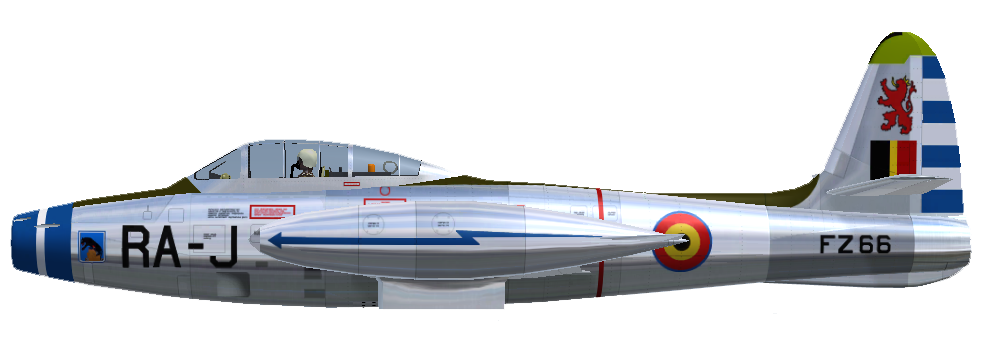
Second World War
Forming the 10th Wing
Thunderjet period
Thunderstreak period
F-104G Starfighter period
F-16 Fighting Falcon period
Thunderjet period
June 1, 1952:
Lt. Col. Av. Du Monceau de Bergendael becomes the first commander of the 10th Wing.
July 1952:
The first twin engine Oxfords are delivered as liaison aircraft. Every squadron is assigned one Harvard T-6, eventually however, only one is delivered in July, 1952.
Second part of 1952:
The Wing is preparing for a new era. A group of pilots is send to Florennes to convert to F-84G Thunderjet. Operational life in the 10th Wing is mainly centered around the 27th Sqn, the other two squadrons basically exist on paper only.
August, 1952:
The first batch of F-84G’s are flown in directly from Copenhagen, Danmark. These brand new jets on indefinite loan from the USA, still carry their USAF registrations. Follow-on deliveries are flown over from Florennes, consisting of jets already used by the 2nd Wing. These aircraft receive the ‘RA’ 27th Squadron-code immediately.
October 1952:
The first T-33 Shooting Star jet trainer is flown in from Copenhagen, Danmark. The T-33 is the two-seat version of the famous P-80 Shooting Star and just like the F-84 they are on loan from the USA. They are to be used to fulfill the yearly instrument check flight requirement of the Thunderjet pilots. For this purpose every F-84 Wing receives a few T-33s.
February 23, 1953:
The official move of the three squadrons to the assigned new airbase Kleine-Brogel starts the 23rd.
The 23rd and 27th Sqn on Februari 24th, the 31st Sqn on March 20th (23 and 31 without airplanes). Although these are the official dates, one day earlier three formations of jets, ten in total, already leave Chièvres for Kleine-Brogel.
For this flight the formation call signs reflect the squadron colors: Seaman Blue (27), Seaman Red (23) and Seaman Yellow (31). The formation leader is the new Wing Commander, Lt. Col. Du Monceau de Bergendael.
March 23, 1953:
The Wing starts to grow. The 23rd Sqn moves to its own dispersal and becomes an autonomous unit. The 31st Sqn however remains a paper duck.
Concrete troubles:
The brand new taxi tracks at Kleine-Brogel are already showing cracks and start to crumble. This is a dangerous situation for the jet engines of the brand new aircraft.
May 28, 1953:
Due to this hazard, the 10th Wing moves to RAF Geilenkirchen, Germany. The 27th and the 23rd Sqn acquire their own dispersal on this crowded RAF Airbase.
A nomadic period starts and will last until the construction works in Kleine-Brogel are finished. Only command and maintenance personnel remain on the home base.September 17, 1953:
The operational role of the three squadrons of the 10th Wing is changed from ‘fighter’ to ‘fighter bomber’.
End of September,1953:
The first reconnaissance and training flights take place on the new shooting range at Helchteren, called ‘Pampa Range’.
Around this time the US registrations on the newly arrived aircraft are removed and replaced by squadron-codes on the side of the forward fuselage the same way the 27th Sqn did a year before.(‘Z6’ for the 23rd, ‘RA’ for the 27th and ‘S8’ for the 31st Sqn). Specific squadron colors are being applied (red/white for the 23rd, blue/white for the 27th and yellow/black for the 31st Sqn).
The 31st Sqn transfers to RAF Geilenkirchen. In December 19th however, it is reassigned back to Kleine-Brogel without aircraft.
The 31st Sqn is renamed 31st Instrument Flight and flies T-33 only.
December 21, 1953:
As of Januari 8th, the 234th Sqn RAF joins Geilenkirchen. Due to lack of dispersals the 23rd Sqn has to move to nearby RAF Brüggen (D).
June 1, 1954:
The 31st Sqn deploys to Weelde (B), an auxiliary airfield.
June 18, 1954:
The 31st Sqn starts to fly Thunderjets. The squadron consist of two flights: one flying T-33s and one flying F-84Gs.
As a result of a reorganization of flight training, all T-33s are concentrated in the Operational Conversion Unit (OCU) of the Fighter School at Koksijde Airbase and as from January ’57 at Brustem Airbase where all instrument qualification flights are conducted.
September 1, 1954:
The 27th Sqn deploys to Weelde (B).
September 15, 1954:
The 23rd Sqn deploys to Weelde (B).
October 20, 1954:
The 31st Sqn operates out of Bierset Airbase (B).
October 20, 1954:
Lt. Col. Dewever assumes command of the 10th Wing.
October 29, 1954:
The 27th Sqn is the first squadron of the Wing to deploy to Sylt, Germany, for air-to-air exercises. It returns to Kleine-Brogel in November 19th.
November 22, 1954:
The 23rd Sqn deploys to Sylt and returns to Kleine-Brogel on December 21st.
January 28, 1955:
The 31st Sqn returns to Kleine-Brogel.
June, 1955:
Due to maintenance requirements, the total number of available aircraft becomes very low and needs to be replenished by older F-84 E-type out of the depot at Wevelgem (B).
March 7, 1955:
Lt. Col. Morai assumes command of the 10th Wing.
May 12, 1955:
During a ceremony at the Jubelpark, Brussels, Lt. Col. Morai receives the standard of the 10th Fighter Bomber Wing out of the hands of His Majesty King Boudewijn.